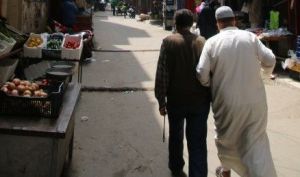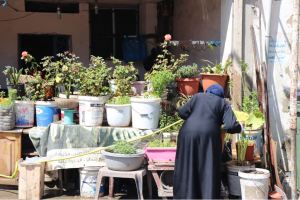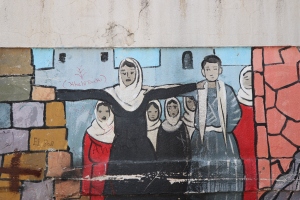In this blog post Sorcha Daly reflects on the use of imagery in international NGOs’ campaigns and the influence of these images on conceptualisations of the ‘global South’ and ‘processes and structures of inequality’ found in humanitarian discourse and action. Daly argues that these images contribute to the construction of a distant, at times ‘primitive’ other, and a conceptualisation of the ‘global South’ as a place of constant, decontextualized and de-historicised emergency and crisis. Daly further argues that ‘humanitarian action is then also reduced to reacting to these ‘emergencies’’ rather than proactively contributing to ‘addressing the development and political rights of communities.’
If you find this piece of interest please access our recommended reading at the end of this piece, or access our Introductory Mini Blog series, or our Thinking through the Global South series.
On reflection: imagery and imaginations in humanitarian action
By Sorcha Daly, Project and Communications Co-ordinator, Southern Responses to Displacement
Since 2011, aid programmes have been implemented in Lebanon, Jordan and Turkey by diverse humanitarian agencies and donor states to assist refugees from Syria. However, within the dominant humanitarian discourse, multiple responses from the ‘global South’ are often rendered invisible, as we have been examining in the Southern Responses to Displacement project. Indeed, ‘the global South’, a term that our project is critically exploring, is often conceptualised in the ‘global North’ through specific frames of reference that remain un-challenged and dismiss or ignore conceptualisations from ‘the global South’.
One of the ways that the ‘global South’ is represented and ‘constituted’ by the ‘global North’ is through the use of imagery promoted by large international NGOs’ marketing departments. This blog examines the politics of representation arising through the use of imagery promoted by large, international NGOs and explores how a critical analysis of these conceptualisations of the ‘global South’ can bring to light and challenge some of ‘the processes and structures of inequality’ that underpin humanitarian discourse and action.
It is important to note that INGOs’ fundraising campaigns are often acting in response to cuts in government funding for aid, and critiques of marketing and fundraising campaigns must therefore be situated against this backdrop. Nonetheless, the presentation and consumption of imagery about and of the global South, by and, for the most part, for consumption in the Global North, is problematic. It can contribute to the construction of a ‘distant other’ and the persistence of humanitarian practices that influence engagement with and the instrumentalisation of local humanitarian actors, based on the acceptance, conscious or otherwise, of unequal structures.
Before starting this blog I quickly looked at the imagery used by some of the largest INGOs on Twitter. Multiple images, many of countries experiencing war, including Syria, many of children struggling to live within states of crisis and emergency, appeared within this brief review. Although these images portray current situations, the images and the stories they tell are de-contexualised and de-historicised, often reducing whole communities in and of the ‘global South’ to a single, reductive narrative constructed by and in the ‘global North’.
The use of this imagery contributes to what Calhoun describes as the construction of an “emergency imaginary.” For those of us consuming these images we are left with the perception that, for some countries and communities, particularly those of the global South, there is a constant, yet unpredictable, state of emergency; this is instead of recognising that these ‘emergency’ situations are, in fact, predictable, often foretold by multiple experts, and the result of structural inequalities (as Fiddian-Qasmiyeh argues here), that are left unchallenged or are even upheld within the ‘state of emergency’. The implications of these perceptions are far reaching, particularly within the strategic planning and practices of governmental and non-governmental humanitarian agencies, and their promotion and support of North-South, rather than South-South, humanitarian action and cooperation, as explored by the Southern Responses to Displacement project here.
When humanitarian imagery promotes this ‘emergency imaginary,’ humanitarian action is then also reduced to reacting to these ‘emergencies’ rather than addressing the development and political rights of communities, themes that have been further explored and problematized here and here. Further, and as noted at the beginning of this blog, it renders the humanitarian responses of the ‘global South’ invisible within the ‘global North’ and within dominant humanitarian discourse (see here). Even now, when South-South Cooperation and humanitarianism, (including internationalist and solidarity based approaches, faith-based and refugee-refugee humanitarianism) has been ‘identified as ‘central to development and responses to natural hazards’ it is nonetheless, as a mode of response, often perceived by states and UN Agencies as ‘incompatible with conflicts and conflict-induced displacement’ (as argued here and here).
This dominant narrative also has an impact on a smaller scale. As Kathleen Rutledge notes in her blog ‘Barriers to Localisation: Making the Invisible Visible’, during her time as a humanitarian director for almost 10 years, local faith groups were, and still are, often seen as a nuisance and have long been ignored by large INGOs in favour of what are seen as more professional local non-faith-based groups. Even then, local groups are seen as ‘stakeholders to be engaged, not leaders in design and implementation.’ Kathleen reflects that she has
‘Come to recognise that I have given more attention to how I can help local actors adapt to international expectations, than to how aid as I know it needs to transform. I have not asked these questions enough: What capacity do I need for local groups to develop in me? What would they like to mobilise in me? What would it look like if I shifted from capacity building to capacity sharing?’
With these reflections of a humanitarian practitioner in mind, it is possible to gain a greater understanding of how our own conceptualisations of humanitarianism, humanitarian actors, and those receiving humanitarian aid are influenced by the imagery used by INGOs. Why is it that, as Carpi argues elsewhere on Southern Responses to Displacement, ‘rethinking inclusion is as hard as eradicating exclusion’ and why do ‘we tend to use “including X” to emphasize the positive – and therefore self-entitled – act of enclosing an outside within a centre’?
As I reflect on my own experiences of ‘consuming’ humanitarian imagery I am reminded of the use of collection boxes distributed to Irish children by Trocaire, one of Ireland’s oldest and most well-known humanitarian agencies. In the 1970s, the imagery used on the boxes was most often the image of an ‘African’ child. This imagery has changed over the years, and for a period of time Trocaire stopped using images of children from the ‘global South’ in its campaigns. However, in Trocaire’s 2012 Lenten campaign, the organisation returned to using images of children. A recent study examining the use and impact of imagery in its 2012 campaign found that the images were based on ‘neo-colonial stereotypes about Africa as a primitive place dependent on Western aid’ and that Irish school children conceptualised the children as ‘hopeless’ and ‘primitive’.
Undoubtedly, when examining the imagery used by humanitarian INGOs’ marketing and fundraising campaings, it is also important to reflect on the multiple and diverse influences that impact the motivations and practices of humanitarian practitioners and the organisations they work for. However, at a time when strategists continually seek ‘quick wins’, a move towards critically questioning the use of imagery in humanitarian campaigns and a simple switch to representing displacement through a lens of ‘spaces and places, not faces’ (as Fiddian-Qasmiyeh suggests) could contribute to a clearer focus on re-conceptualising the ‘global South’ and the ‘global North’ and, in turn, supporting more effective, egalitarian approaches to humanitarian discourse and action.
**
If you find this piece of interest please access our recommended reading below, or access our Introductory Mini Blog series, or our Thinking through the Global South series.
Carpi, E. (2019) Syrian Faith Leaders in Displacement: Neglected Aid Providers?
Carpi, E. (2019) Intermediaries in Humanitarian Action: The Case of Lebanon
Carpi, E. (2019) Thinking Power Relations across Humanitarian Geographies: Southism as a Mode of Analysis
Carpi E. (2018) ‘Southern’ and ‘Northern’ assistance provision beyond the grand narratives: Views from Lebanese and Syrian providers in Lebanon
Fiddian-Qasmiyeh, E. (2019) Looking Forward: Disasters at 40
Fiddian-Qasmiyeh, E. (2019) Exploring refugees’ conceptualisations of Southern-led humanitarianism
Fiddian-Qasmiyeh, E. (2019) Histories and spaces of Southern-led responses to displacement
Fiddian-Qasmiyeh, E. (2018) Thinking through ‘the global South’ and ‘Southern-responses to displacement’: An introduction
Fiddian-Qamsiyeh, E. (2018) Refugee-Refugee Humanitarianism
Fiddian-Qasmiyeh, E. (2018) Disrupting Humanitarian Narratives?
Fiddian-Qasmiyeh, E. and Daley, P. (2018) Conceptualising the global South and South–South encounters
Olliff, L. (2019) Refugee diaspora humanitarianism and the value of North/South distinctions in research on responses to forced displacement.
Omata, N. (2019) South-South Cooperation in International Organizations: Its Conceptualization and Implementation within UNDP and UNHCR
Featured image: A collection box on the streets of Hamra, Beirut. (c) L. Harsch, 2019



